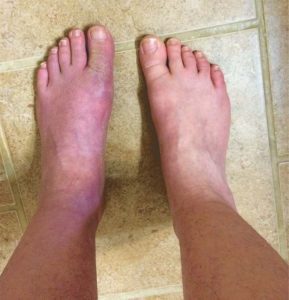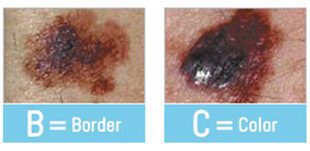By Premier Foot & Ankle Specialists


Signs and symptoms of CRPS include:
1. Constant burning or throbbing pain of the affected extremity
2. Hypersensitivity to cold or touch
3. Chronic swelling of the affected area
4. Skin temperature changes that alternate
between cold and sweaty
5. Skin color changes, that can range from pale white, to red or blue
6. Decreased mobility of the affected body part
7. Joint stiffness and inflammation
8. Changes in the texture and growth of nails and hair
The symptoms of CRPS can range from mild to severe, and can last for months to years. Symptoms can change over time and vary from person to person. The first changes to occur are usually pain, swelling, redness, along with temperature changes and hypersensitivity to cold and touch. Many clinicians categorize CRPS in stages, although there are no specific cutoffs between symptoms and signs between each category. Stage 1 is characterized by changes in skin temperature, that switches between warm and cold, faster growth of hair and nails, joint pain and muscle spasms, severe burning, aching pain that worsens with touch, and skin that becomes blotchy, purple, pale, red, thin or shiny. Stage 1 can last between one to three months. Stage 2, which lasts from three to six months, is characterized by continued changes in the skin, brittle nails that crack more easily, worsening of pain, slower hair growth, and joint stiffness with muscle weakness. Stage 3 continues beyond six months and features irreversible skin and bone atrophy, muscle wasting, tightening of muscles and tendons, along with progression of pain to the entire limb. The changes seen in Stage 3 are often irreversible.
Diagnosing CRPS can be difficult due to the complexity of the symptoms and similarities between other conditions. There is not a single test for diagnosing CRPS, but is important to rule out other conditions so that the diagnosis can be made by exclusion. Several diagnostic tests may include: thermography that shows temperature changes and lack of blood supply in affected limb, bone scans, nerve conduction studies, x-rays, and testing of autonomic nerves (that control sweating and blood pressure).
There is no cure for CRPS, but the progression of the disease can be slowed down. There are a number of treatments focus on reducing symptoms and restoring movement and function of the affected limb, which include:
1. Physical therapy can be started early on to help reduce pain and swelling, increase range-of-motion, and improve muscle strength of the affected limb.
2. Medications can be prescribed such as pain medication, steroids, blood pressure medicines, bone loss medications, and anti-depressants.
3. Hot and cold therapy
4. The use of a TENS (transcutaneous electrical nerve stimulator) unit
5. Nerve blocks (injecting medicine to numb the affected nerves that are causing pain)
6. Surgically implanted pain pumps or spinal cord stimulators, along with surgical nerve ablation
Complex regional pain syndrome can be difficult to diagnose and treat, but the outlook is much better with early diagnosis. In some people, the symptoms can resolve on their own, but other cases can become chronic and potentially irreversible. If you or a loved one are experiencing symptoms similar to those above, contact your local podiatrist for evaluation. Dr. Roggow and Dr. Bonjorno are happily taking new patients and look forward to meeting you!
The caring supportive staff at Premier Foot & Ankle Specialists are available to answer your questions and make your appointment. Please visit their website at www.premierfootandanklefl.com, or call them direct at (941) 488-0222.
PREMIER FOOT & ANKLE
(941) 488-0222
www.premierfootandanklefl.com
4120 Woodmere Park Blvd, Suite 5, Venice, FL 34293
 Southwest Florida's Health and Wellness Magazine Health and Wellness Articles
Southwest Florida's Health and Wellness Magazine Health and Wellness Articles

